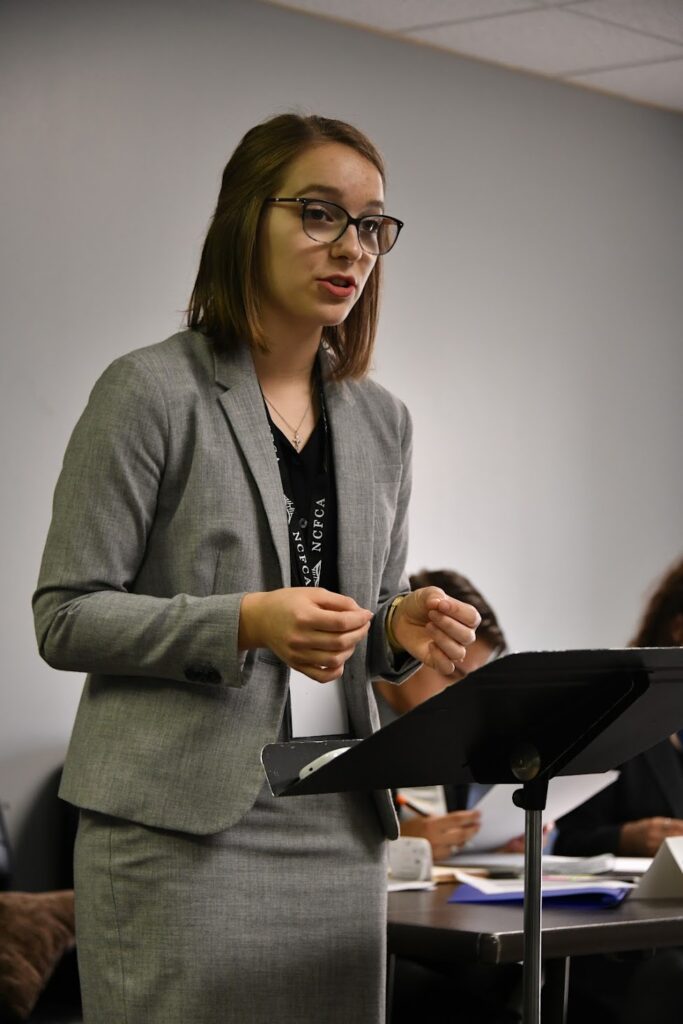
Public speaking is hard. Success requires a lot of blood, sweat, and tears, but it is an incredible opportunity to share what’s important to you. The idea of writing a platform speech, let alone a speech using visual aides, such as Digital Presentation or Expository can often feel like an impossible task. Memorizing 10 minutes of words and a powerpoint presentation? Forget it! For many, the draw to a digital presentation is the desire to play with animations, fonts, colors, and cool slide transitions for hours. With a digital presentation (DP) you can just go to town with all of your neon, cursive fonts, and spinning slides, right? Not so, my friend! Today, I’d like to share some of the most helpful things I learned in creating and giving my DP, to help you as you create and present yours…
- Digital Presentations are platform speeches first
This might seem a little obvious, but I think it’s really important to remember: your DP or Expos or ANY visual presentation speech needs to be a good platform first in order to be considered good. If your speech doesn’t connect with your judges, if they can’t understand it, or you don’t care about your topic, you won’t succeed – regardless of your digital prowess. Focus on writing a good platform and then make your presentation. Your slides are meant to help accent and add to your speech, not the other way around.
- Consistency is key
Your slides can easily become a distraction if you’re not careful. Being consistent with the layout, colors, and font of your slides is a great way to help limit distractions and make all your slides tie together beautifully. I know it’s tempting to fall into the black hole of FONTS and colors, but resist! Your judges will be grateful. A good rule of thumb is to use maximum 2 fonts throughout the whole presentation, and try and pick one thing (shape, picture, symbol, etc.) you’re going to have on EVERY slide. (For example, my speech was about America’s political system and I had two small blue and red lines on the left hand side of every single one of my slides.) Also, if you have colored font on two different slides, use the exact same color both times.
- Limit the number of words on your slides
Your slides should help judges follow your speech – not distract from what you’re saying because they’re trying desperately to read paragraphs of text on your slides. Text can absolutely help, but too much can take away from the words coming out of your mouth. Write in bullet points, not paragraphs! Remember: with judges now viewing your slides on your device or via screen-sharing on theirs, the slides are not going to be that big. So, in order for your text to be read easily, it has to be relatively large, meaning that there can’t be that much of it on each slide.
- The best speeches capitalize on the digital medium
I highly recommend watching the DPs or the Expository Speeches that won or made it to Nationals the past couple of years on Youtube. Some of the best speeches used some really incredible animation. They used all of the capabilities of the digital part of their speeches. So, aim to take full advantage of all aspects of the digital medium (all you coders/animators, this is your time to shine!). To those of you who don’t have such skills, fear not! You can still do really well. I used exactly 0 seconds of my audiovisual time, absolutely no animation, and got 7th at Nationals. I did, however, use my slides to clearly visually lay out the process of ranked-choice voting – something that would have been much more confusing without my slides. My point is simply that while everyone doing a DP should aim to really capitalize on the digital part of their speeches, that looks different for everyone based on their abilities and the content of their speeches.
I want to encourage you to take my advice with a grain of salt. I by no means have digital presentations or expository exactly figured out, nor am I the best at writing or giving them. However, I do hope that what I learned can help you write your speeches and take full advantage of this exciting category. Remember they are speeches – your DP needs to be a good platform before it can become a good DP. Your presentation can be incredibly helpful in explaining complex topics and engaging your judges, but it can also be noisy and distracting. I know you have something that your judges need to hear, and I would hate for your presentation to distract from your message. Finally, show the world your computer prowess! Or don’t. Either’s totally okay!
Bio: Clare is a high school senior who has competed in NCFCA for the past four years. While she’s competed in a wide variety of speech categories, her favorites have been her platform on the importance and impact of public libraries, which won a regional tournament, and her Digital Presentation on the American political system, which won 7th at the 2021 Online National Championship. Clare has a special passion for Moot Court and Team Policy debate. She has won one tournament in Moot Court, and has placed in the top 3 TP teams at 7 tournaments, including placing second at the 2021 Online National Championship.